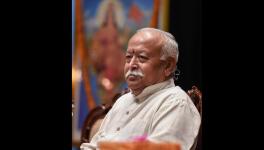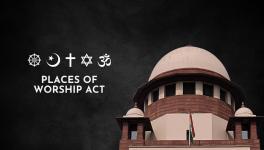Secular, Secularism and Secularity
Image courtesy Orient Blackswan
Away from polemics about culture wars and political Islam, what is the interface like between communities of Muslims and the conditions of secular life in India? This was the subject of a seminar on the sociology of religion held at IIT Kanpur in 2014, and its results are collected in Religion and Secularities: Reconfiguring Islam in Contemporary India, edited by Sudha Sitharaman and Anindita Chakrabarty. Communities in the Deccan and Malabar regions are a particular point of focus, but there are also papers on the sharia courts of Uttar Pradesh and the negotiations of identity involved in being simultaneously Muslim and Bengali.
We tend to recognise divergent practices of Islam in terms of sect and denomination, but how do secular differences mark the outlook of religious communities? These may be regional and linguistic differences, or those of age-group, education and skills as reflected in civic activism. Does religion show as internally coherent across such differences, or is the Muslim identity constituted anew, along with the meaning of secularism, in each setting? These are some of the questions we might ask as we observe the varying customs of matrilineal Mappila Muslims confronted by the colonial and postcolonial courtroom, or notice the calculus of electoral politics in the context of the Baba Budangiri dispute in Chikmagalur.
The following are extracts from the Introduction by Sudha Sitharaman and Anindita Chakrabarty, and the chapter “Muslim Subjectivites, Embedded Identities” by Aditya Kapoor, of the book.
Secular, Secularism and Secularity
For more than two decades now, theorists of modernity have grappled with the resurgence of religion and the contemporary salience of politico-religious movements, along with their cognate processes, secularisation and modernisation, across the world (see, for instance, Asad 2003; Casanova 1994; Taylor 2007). One response was to turn the secularisation thesis into a normative rather than a sociological claim: secularisation had to happen if modernity was to be achieved; if some countries were not becoming secular, it was because they were insuficiently modern or because their modernising project had gone astray (Chatterjee 2006: 58). The exposition of the fallacies of linear, deterministic narratives of secularisation theory, ineluctably anchored in the separation of state and church and the private–public divide, foreground the dynamic nature of the publicness of religious imagery and values that universalise not only European experiences of the Western development path, but also the transferability of the concepts in studying colonial and postcolonial societies.
It is worth remembering that the current wave of theorising secularism was initially situated within a postcolonial context, both geographically and theoretically. And therefore, a spate of studies began to interrogate the monolithic understanding of secularism, and the variation of forms that this separation of state/politics and religion may take, thus, providing a picture of secularism that better fitted the actual practices of modern secular states (see, for example, Asad 2003, 2006b; Bilgrami 2006; Connolly 1999; Sullivan 2005). The strategy employed to dislodge a Eurocentric way of being secular was to espouse multiple secularities.
As opposed to the concept of secularism, an ideological– philosophical project, and secularisation that signifies both the process of differentiation, including diminishing mutual influences between religion and other social domains, as well as the decline in religious participation and belief, Wohlrab-Sahr and Burchardt (2012: 876) have initiated a discussion on secularity in terms of the cultural meanings underlying the differentiation between religious and non-religious spheres. In contrast to the political ideologies of separation, the concept of multiple secularity detects a variety of combinations of religion, national politics and the claims of religious groups and secular agents carried into the public sphere. They frame the concept not around the question of whether secularism/secularity are culturally inauthentic and a Western import, but in terms of how the boundaries between religion and the secular spheres are negotiated, challenged and redrawn in secular democracies.
As a number of scholars have shown, the categories of secular and the religious are not opposites of each other, but are closely intertwined in paradigmatic ways in modern nation states (see, for example, Agrama 2012; Asad 2003; Baubérot 2000; Connolly 1999; Keane 2007; Taylor 2007). The emergence of the modern category of the secular (in contrast with the pre-modern Latin term saeculum) is constitutively related to the rise of the modern concept of religion wherein it is impossible to track the history of one without simultaneously tracking the history of the other (Mahmood 2008: 462). Religion thus needs to be unpacked just as much as secularism as a concept.11 Apart from the fact that ‘religion’ and ‘secular’ interpenetrate, it is modern law that is crucially involved in defining and defending the distinctness of social spaces, especially the legitimate space for religion. Thus, endorsing Asad (2006a: 209), what is of interest to us is the point that, ‘(L)aw finds itself continually having to redefine the space that religion may properly occupy because the reproduction of secular life ceaselessly disturbs the clarity of its boundaries’. In India, with its widely divergent religious traditions, both religious beliefs and practices, historically, have taken the form of politically negotiated religious settlements and varying religion–state arrangements.
From “Muslim Subjectivites, Embedded Identities”, by Aditya Kapoor
During fieldwork, I found that my Muslim respondents acknowledge that many of their religious and ritualistic practices are influenced by sources other than Islam. But they do not see these practices in tension with Islamic tenets. Their subjectivities are constituted through practices in terms of farz, niyom and parampara. Farz means duty—it is a set of religious instructions that are obligatory in nature, such as praying five times a day or not indulging in usury. These duties cannot be compromised or negotiated. Niyom consists of a set of practices and rituals that are informed by scriptures. Most of the constituting elements of niyom are informed by the Hadith, and the traditions of the Prophet or Sunnah. They are desirable to be followed to be a good Muslim, but they may not be obligatory. Parampara means local traditions; it has cultural underpinnings. These are practices that are followed by Muslims by virtue of being from a particular region. A good number of constituting elements of parampara consist of practices that are influenced by local Hindu rituals. It has shaped the way Islam is followed in this region. For example, offering sinni (a sweet made of wheat-flour and sugar, usually offered to Lord Krishna by Hindus) at the shrines of dead Muslim saints or any inanimate object like a rock or a tree considered as a pir is a widespread practice among the Muslims of this region. Parampara, in general, has nothing much to do with Islamic scriptures, but in certain cases, it can articulate Islamic idioms. Parampara does not figure in any authoritative scripture like the Quran or the Hadith. Nonetheless, it plays an important part in the construction of an embedded worldview and uses a variety of other sources. Rituals like applying turmeric paste on the body of the bride before marriage or the celebration of olima have nothing specifically to do with Islam, but such practices are part of the everyday life of Muslims, indicating their embedded character in any cultural and geographical context. In spite of constant opposition from the pirs of Furfura Shareif, such practices are followed in everyday life.
Let me elaborate this point by citing another example. In a conversation with a madrasah student, I was informed that Muslims in West Bengal consider Thursday to be an auspicious day and do not slaughter animals on that day. Interestingly, he said that Thursday being lakkhibar is auspicious. When I asked him to explain this, he was unable to provide any reasonable answer, but he insisted that, ‘there is nothing as such in niyom, but we consider it as auspicious as it is part of our parampara’. After a pause, he elaborated:
Even if a person dies on Thursday, we consider it to be gracious. In Islam, we believe that life does not end after death. Even a dead body has feelings as the soul does not leave the body just after death, and the body feels pain after death in the grave for the sins the person has committed in his lifetime. The farista [angel] takes the soul out of body only on Friday, on the day of juma. So, if a person dies on Thursday, then the duration of suffering in the grave will be less and the soul will part the body on Friday.
Here we see how beliefs, like those associated with lakkhibar, are defined as parampara or tradition and they coexist in harmony with scriptural religious tenets. Moreover, local Muslims are not ignorant of the scriptures, but the way they construct a tripartite division between farz, niyom and parampara is reflective of the diverse sources of their religious and ritualistic practices. Therefore, being a Muslim can be seen as a dynamic process, as Muslims acknowledge the Hindu roots of certain custormary practices, but they do not see them in contradiction with Islam. In a conversation on this matter, a villager informed:
We follow many practices, which have nothing to do with niyom. They are our parampara and they are aanchalik [pertaining to a particular region] in nature. These practices are part of the cultural environment of this region, and not all of them are exclusively Hindu. There is nothing wrong in practising them as one cannot eliminate the local influences of the region on our religious practices, provided it does not violate the core of Islam.
This narrative highlights how the local and the ‘religious’ are perceived and articulated. They are aware of being a Muslim and a Bengali, with their rituals and practices being conditioned by multiple sources. Textual traditions are not the only source that constitute their identity. Muslims negotiate these categories according to their pragmatic concerns. The case of Furfura corroborates to an understanding of everyday ethics in the Foucauldian sense, where the processes of subjectivation (self-formation) takes place in a field that has multiple sources of constitutive moral spaces, religion being one of them.
These are excerpts from Religion and Secularities: Reconfiguring Islam in Contemporary India edited by Sudha Sitharaman and Anindita Chakrabarti and published by Orient Blackswan. Republished here with permission from the publisher.
Courtesy: Indian Cultural Forum
Sudha Sitharaman is Professor, Department of Sociology, Pondicherry University, Puducherry.
Anindita Chakrabarti is Associate Professor of Sociology, Department of Humanities and Social Sciences, Indian Institute of Technology, Kanpur.
Get the latest reports & analysis with people's perspective on Protests, movements & deep analytical videos, discussions of the current affairs in your Telegram app. Subscribe to NewsClick's Telegram channel & get Real-Time updates on stories, as they get published on our website.
























